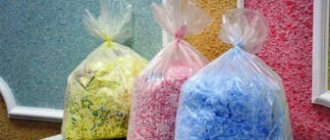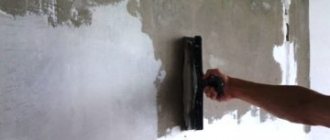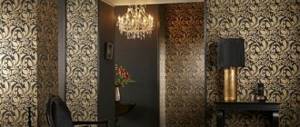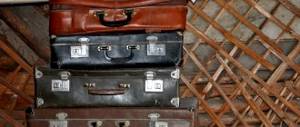Content
If you have to clean a wall plastered with cement mortar and putty, and the wallpaper, although it has lost its appearance, has not lost its strength (it does not tear under your hands), consider yourself lucky, because you can handle it in a few minutes. But if the coatings are thin, easily torn, and even if they were glued with PVA glue, it will seem to you that it is easier to cover the wall with plasterboard than to get rid of the hated wallpaper sheets. Of all the types, the hardest to remove are old paper ones from Soviet times. This is due to the characteristics of the material, the quality characteristics of the glue used in those days, at best - CMC, at worst - Bustilat, wood glue, PVA. Such coatings are almost impossible to tear off as a whole sheet. They have to be scraped off with force, centimeter by centimeter. This is quite a tedious task.
Before pasting the walls, the old material must be completely removed
Previously, before pasting the walls were prepared by gluing newspapers. If there was already a paper covering on the walls, then they did not remove it, but simply applied a new one on top of the old one. Over the years, many layers may have accumulated on the walls, firmly glued to each other. Leaving such a disgrace on the wall is not hygienic: mold and various insects often appear. This causes an unpleasant odor in the apartment.
The situation is especially dangerous when there are small children in the house, because fungal damage to the walls is the main cause of allergic diseases. To free yourself from all these remnants of the past, there are several ways described below.
What tools are useful for the job?
In order for the process to go quickly and “painlessly”, be sure to prepare the tool. You will need:
- several spatulas of different widths;
- a bottle with a sprayer into which water will be poured;
- a damp soft cloth;
- detergent with hot water;
— iron with steam function;
- stepladder or stool.
These tools should be quite enough. However, different types of wallpaper are removed in different ways. You may need something else.
Tools and materials ↑
- a bucket of warm water, to which it is better to add dishwashing detergent;
- paint roller, foam sponge or sprayer.
- metal spatula or scraper;
- ladder;
- masking tape;
- polyethylene film;
- chemical wallpaper removers;
- knife;
- metal brush;
- iron and a piece of cotton fabric.
It is more convenient to shoot from top to bottom. You should pry the top edge with a spatula, then pull it down, prying up the poorly lagging areas. This may be quite enough. But if the wallpaper doesn't come off well, you will need additional moisture to soften the old glue.
It is convenient to work from top to bottom, “picking up” firmly attached areas with a spatula
Necessary tools for removing old wallpaper
Necessary tool
The work ahead is dusty, we remove everything unnecessary from the room and cover everything that remains with foil. It would not be amiss to cover the floor with oilcloth in order to protect it from contamination and the ingress of chemicals that we may use. We prepare in advance:
- putty knife
- stationery knife
- paint roller
- large soft sponge
- ladder
- needle roller
- spray
- garbage bags
- molar tape
To shoot or not to shoot?
Next, we will determine the complexity of the coating to be removed. If the wallpaper is non-woven, most likely it will be easily peeled off as a single piece. If we see vinyl or paper wallpaper, we have to suffer, because... they will tear and leave marks that we must completely remove. If you are convinced that the wallpaper is difficult to remove, you should immediately think about a solution for removing dried glue.
We suggest you familiarize yourself with: Wall insulation with polystyrene foam
You can get by with a regular aqueous solution with the addition of vinegar or laundry soap. But for the most problematic options, it is advisable to buy a special product. Such solutions have a more targeted effect, absorbing under the wallpaper, they destroy the structure of the adhesive and make it easier to deal with problem areas where the adhesive has tightly adhered to the wall.
Special wallpaper remover
It is allowed to begin collecting the necessary tools after preparing the room in which repairs are planned. It is important that everything you need is at hand. Then the dismantling process will be quick. Below are the tools that will definitely come in handy for removing old wallpaper:
- Folding ladder;
- Large garbage bags;
- A roller that soaks well or a sponge;
- Stationery knife;
- Emery scraper;
- Regular scraper;
- Thin spatula;
- Spray;
- Hammer;
- Unnecessary fabric rags;
- Sander;
- Latex gloves.
In addition, you need to prepare a container for hot liquid, and also put on unnecessary clothes and shoes.
It is important that everything you need is at hand.
Work order ↑
- Before you start work, you must follow basic technical safety rules, because there are electrical switches and sockets on the walls. And in your work you may have to use water or other conductive liquids. Therefore, during the work, it is necessary to turn off the electricity and cover the sockets, wires and switches with masking tape.
- Using tape, you need to glue a plastic film at least 50 cm wide to the baseboard. The other end of the film is glued to the floor. This will make the cleaning process easier.
- We soak the old coatings with warm water and dishwashing detergent or liquid soap. There is no need to immediately tackle a large area, because while you are scraping in one place, it will already have time to dry in another. For better penetration of water, the surface of the wallpaper should be scratched with a knife or scraper. After swelling, clean the wall with a spatula. You can use special chemical removers. According to the instructions, a solution is prepared and applied with a sponge or spray. Such washing solutions have high permeability and destroy the adhesive layer well, after which removal will not be difficult.
Features of removing old paintings
In fact, it is easy to remove old paper wallpaper from almost all surfaces, only if they were glued in one layer and not with super glue. Another thing is paper wallpaper, mounted on the wall in several layers. Here you will have to work hard to peel off this multi-layer coating.
If the wallpaper has been glued correctly, tearing it off the walls is easy.
This incident occurs because many people really like to glue a new layer of wallpaper without removing the old one. This is how human laziness leads to a not very good effect. For example, uneven wall surfaces. The fact is that the previous layer could not have been made very well, which is why tubercles formed, this is the old wallpaper standing up. In the end it will look extremely unaesthetic and sloppy.
In addition, the likelihood of freshly hung wallpaper peeling off in this case increases, and hygiene decreases. As a rule, old wallpaper can hide a layer of mold, which it would be advisable to get rid of before carrying out repairs by quickly stripping everything off the walls.
Therefore, it is best not to be lazy, spend your time, remove wallpaper from the walls, and are guaranteed to get an excellent result. If you decide to carry out cosmetic repairs, we advise you to get rid of old wallpaper as efficiently as possible - this is the very first and most important step. To make this process easier, they can be moistened generously with hot water and detergent. It is best to apply with a sponge or cloth. Old wallpaper will actively absorb moisture, swell, after which it will be easier to remove it.
Rollers with fur and velor coats are able to absorb more moisture
It’s worth clarifying here: it’s better to wet the layers one by one so as not to let them dry out again. Take one fragment, process it and leave for 10 minutes. But it’s also better not to overdo it with water, because excess moisture can disrupt the structure of the layer of plaster or putty.
Related article: Instantaneous water heater: principle of operation, installation tips
Most often, after applying a copious amount of water, old paper wallpaper, as a rule, comes off the walls on its own, however, this cannot be done without available tools. To remove the material even more effectively, you need to use a construction spatula - in this case the process will go much faster. If hot water doesn’t really help, we’ll use another excellent expert tip: steaming the material with an iron through a damp cloth. As a rule, after all these procedures, it is possible to remove all the old wallpaper, and the walls are completely cleaned.
It is better to use a spatula with sharp edges; choose the width yourself
It’s a different matter if we work with special wallpaper on a rough paper base. In this case, you should resort to the perforation method - making cuts on the paper (use a spatula or a special knife). For the same purposes, manufacturers offer rollers with nails, however, you need to be extremely careful with them, because you can easily damage the bottom layer of putty. After working with such a tool, all that remains is to wet the old wallpaper and remove it from the wall after 10 minutes.
Pay attention to special liquids for removing wallpaper. These materials are safe for human health and are very effective because they accelerate the process of moisture penetration and remove strong adhesive solutions. The liquid is very easy to apply and is quite economical to use. It is best to use a brush, distribute the material evenly over the wallpaper, leaving it for 2-3 hours. After that, arm yourself with a spatula and simply clean the wall in layers without difficulty.
The most unclaimed of all possible options is the use of glue with the addition of PVA. If old paper wallpaper was glued in this way, it will be extremely difficult to remove it. This is because they cannot be steamed or soaked; even sandpaper is unlikely to overcome them. Under such conditions, you can use an additional attachment in the form of a brush for a drill.
In this case, it will not work without disadvantages, because the nozzle will most likely damage the main layer of putty, and the wall will have to be leveled again. Sometimes the damage reaches the concrete layer, which is not very pleasant, but is easily fixable.
Be very careful when using such attachments.
The final stage will be drying the walls. After all the manipulations to remove the wallpaper have been carried out, the walls have already absorbed the required level of humidity; there is no need to quickly carry out further work. If you don’t want this to result in moldiness and dampness later, and the new wallpaper is glued well, dry the wall and apply an additional layer of primer.
Related article: Calais Castles: company overview
Another important recommendation is that a new layer of wallpaper must be applied in the complete absence of a draft and only with the windows closed. A draft can wreak havoc on a fresh renovation and result in you having to redo everything. After 24 hours, you will be able to fill the room with air.
If you can’t remove the wallpaper using the usual method ↑
If soaking does not give the desired result, try steaming using a piece of wet cotton cloth and an iron. It is necessary to scrape while the walls are hot.
If there are still adhesive residues that cannot be removed in any way, remove it with coarse sandpaper, preferably using a sanding machine. Any unevenness remaining on the walls will need to be puttied.
Modern wallpaper is much easier to clean than old wallpaper.
- Most of them are two-layer, which provides for the possibility of delamination. In this case, you can only remove the outer decorative layer, which has lost its appearance, and the “backing” will remain on the wall and will serve as the basis for new ones.
- Modern wallpaper glue has good adhesive properties and at the same time is easily dissolved with special removers or warm water, which greatly simplifies the process.
The method of removal is determined by the type of wallpaper and the nature of the surface on which it was glued. The walls can be with a durable moisture-resistant surface or made of plasterboard. But the question inevitably arises: how to remove washable wallpaper.
Basic recommendations
If you want to put up new wallpaper, be sure to remove the old one. Some people ignore these recommendations and start gluing directly onto the old coating. However, this cannot be done.
The previous layer holds up worse, despite its apparent strength. The new roll gives additional load, which speeds up the peeling and peeling of the old materials.
In addition, the glue you use to glue the new roll softens the previous paper layer. This increases the drying time and provokes subsequent peeling of the old wallpaper. In addition, the renewed wallpaper, after completely drying or after some time, may become wavy and blistered, or become wrinkled. This is especially true in cases where new materials are much better and of higher quality than the previous ones.
Before removing old wallpaper from drywall, concrete and other types of walls, the room must be prepared for the procedure. To do this, remove all furniture from the room. If some items cannot be moved, cover the items with film or unnecessary cloth.
Before removing old wallpaper from the walls, you also need to cover the floor. You can use film. But to prevent it from slipping, lay cardboard on top or lay thick paper sheets.
If you use water to remove the paper coating, be sure to turn off the electricity or cover the sockets and switches with polyethylene film and secure with tape. Otherwise, there is a high risk of short circuit. And so that during the work process the garbage does not spread throughout the entire area of the apartment or house, place a damp cloth on the threshold of the room.
How to remove vinyl wallpaper ↑
They have two layers. The first is the base, which is glued to the surface of the wall; it can be paper or non-woven. The second is vinyl (polyvinyl chloride), which imparts moisture-resistant and decorative properties. It is not necessary to completely remove them from the walls; they provide the ability to remove only the outer polyvinyl chloride layer. The base remains on the wall, provided that it is securely glued. Depending on the base material, there are paper and non-woven vinyl wallpapers. If you need to completely remove the paper ones, you can first tear off the outer layer, soak the base with water and scrape it off with a metal spatula.
Quick removal of vinyl sheets
Removing old vinyl from room wall surfaces is not an easy task. The reason is that the upper surface of such products is covered with a very thin layer of PVC, which does not absorb moisture.
Vinyl wallpaper has a thicker structure, so it is easier to remove
But you can use the following recommendations to easily and quickly get rid of such wallpaper:
- Carry out all activities from the floor, prying up the wallpaper with a spatula. When removing vinyl-based wallpaper, special care must be taken. If you want to remove the sheets simply, you can heat them up using the hot stream of a regular hair dryer. A heated iron also helps a lot.
- Since vinyl wallpaper is a multi-layer product, it is very difficult to remove it. It is recommended to tear them using a roller with needles or a metal brush.
- Using a spatula, carefully peel away the layer of vinyl wallpaper until it is completely removed.
Parting with the old non-woven fabric ↑
It is advisable to remove only the outer layer, since the remaining interlining, strengthening the wall, will serve as a good base. If you decide to remove it completely, then the non-woven base is stronger than the paper one, so it’s easier to remove it. It is enough to pry the edge with a spatula and smoothly tear it away from the wall from top to bottom, using the spatula to help tear off areas that are difficult to lag behind. If necessary, the inner layer can be moistened during tearing.
Wallpaper perforation device (tiger)
Why do you need to remove old wallpaper?
Not all people who plan to renovate understand that it is necessary to remove the old layer of finishing. After all, some people believe that if old paper wallpaper is tightly glued with bustilate, then it will be a good basis for a new layer. However, this is not quite true.
First of all, keep in mind that the previous finish may lose its original appearance, which can have negative consequences. For example, over time, old paper turns yellow, stains appear on new wallpaper. This defect is almost impossible to correct; the repair will have to be redone.
Additionally, in some areas the finish may fall off over time and destroy the new layer. Therefore, the walls must be prepared for repairs. Naturally, you need to find out how to quickly tear off old wallpaper.
How to “free” drywall from wallpaper ↑
It is not advisable to moisten the surface abundantly - you can damage the drywall by removing it from the cardboard. If the drywall was not primed before pasting, then it will be almost impossible to remove wallpaper coverings from it without damaging the cardboard layer. In order to do this, it is better to use special washes. To increase the effectiveness of the remover, the surface must be scratched or cut; You can make perforations with a knife, spatula, toothed roller or a special wallpaper tiger.
In especially severe cases, when not wallpaper glue was used, but for example PVA, you can try to remove it along with a thin layer of cardboard. Since it consists of thin sheets of paper glued together, you only need to peel off the outer sheet. This should be done carefully, carefully peeling it off using a paint knife. If you decide to do this, do not forget to putty and prime the surface before gluing the new ones.
After perforation and moistening, the wallpaper is easier to remove
Options for removing old paper wallpaper
Paper panels are the easiest to remove. It will be enough just to soak them thoroughly using a respirator or a wet sponge. Then they are pryed with a thin spatula and slowly pulled down. The operation is performed with each canvas, and the remains are removed with a stationery knife.
Paper panels are the easiest to remove.
How to remove liquid wallpaper ↑
This is a decorative and finishing coating for walls and ceilings, consisting of cellulose or cotton flakes with dyes and other components. The composition contains water-soluble glue, with the help of which they adhere to the surface. The glue dissolves with water even after drying. In order to remove liquid wallpaper, you must first soak it well. A spray bottle, foam sponge or rag will come in handy here. It is advisable to wet the surface several times. After they have swollen well, they are cleaned off with a scraper or metal spatula. The mass removed from the wall can be reused if desired.
The work will progress faster if you use a steam stripper to moisten the covered wall.
If the renovation has taken a long time and you are pressed for deadlines, information on how to get rid of old wallpaper using professional tools, such as a steam remover, will be useful. This device is good because it simultaneously heats and moisturizes the surface. Using superheated steam, you can effectively remove old dried glue. The impact on the wall surface is minimal.
Without leaving traditions
Of course, there are traditional ways to easily remove the old coating. Is it necessary to remove old wallpaper at all? Naturally, yes. There is no need to think about this question. It is necessary to take into account that any unevenness, roughness, or any other defect will only have a detrimental effect, and can become the main reason for the peeling off of a new layer of wallpaper.
Stains on the old coating are also dangerous; they can show their color on the new one, and it will not look aesthetically pleasing at all. The room will definitely not be decorated.
Another reason to remove it is the lack of guarantee that the new layer will be able to stick on top of the old one and will not fall off over time. In particular, the new surface involves the use of glue that contains water, which in turn will soak the old layer. Due to this, air bubbles form in some places, which has a detrimental effect on both the appearance and the functional characteristics and durability.
If possible, find the old shortcut; it usually indicates how to remove them. If you don’t find the label, don’t worry, there are a number of universal ways to quickly remove it.
Tool preparation
First of all, before starting work, you need to stock up on the necessary tools and prepare them for use. The following tools will be needed for this work.
- To pry up the joints and remove the sheets, you will need two spatulas: one narrow and one wide. Make sure they are sharp; you can sharpen the edges with sandpaper.
- If possible, you need to purchase a special liquid to remove the wallpaper; in its absence, you can use ordinary warm water. But with a special liquid it will be faster.
- If possible, use a steam mop; it will be very helpful for soaking and removing old wallpaper from the wall.
- It is also necessary to perforate the surface; a roller with spikes, a wallpaper tiger or a knife will help with this. This is a quick way to remove heavy wallpaper.
- Take polyethylene and tape.
- A drywall knife if wallpaper is being removed from a drywall wall.
- Bucket with warm water and sponge.
- Paint roller.
Depending on the type of wallpaper and wall, as well as the cleaning method, the list of tools may vary, but only slightly.
Preparing the premises
First, before starting work on removing old wallpaper, you must carefully prepare the room.
- First of all, it is advisable to remove all the furniture.
- After which it is necessary to protect the floor covering from exposure to the adhesive mass from the old wallpaper.
- Also cover the baseboards with polyethylene; you can secure it with masking tape.
- Make sure outlets and switches are secure. It is advisable to turn off the electricity in the room and cover all power supply elements with polyethylene to prevent the ingress of debris and moisture.
The preparation is complete, you can start working.
Useful tips
Before you rip off your old wallpaper, here are some tricks that will help you do it quickly and easily:
— The wall needs to be moistened with a roller or sponge, while making sure that the liquid does not flow down the wallpaper. In this case, they simply will not be able to get wet well. In order for the moisture to take effect, you need to wait about 15 minutes.
- Please note that the water must be hot.
— If you don’t have a steamer, use a regular wet sheet and a simple iron. To do this, place the fabric against the wall and iron it for a few seconds.
— After removing the wallpaper, you must thoroughly clean the walls of any remaining adhesive. To do this, it is recommended to use special solvents that are sold in stores. You can also use a pumice stone or a scraper.
— You need to start removing the fabric from the seams. At the same time, be especially careful around switches and sockets. Try not to leave a single extra piece on the walls.
That's all. Now you know how easy it is to tear off old wallpaper yourself. It won't take much time. Good luck!
fb.ru










